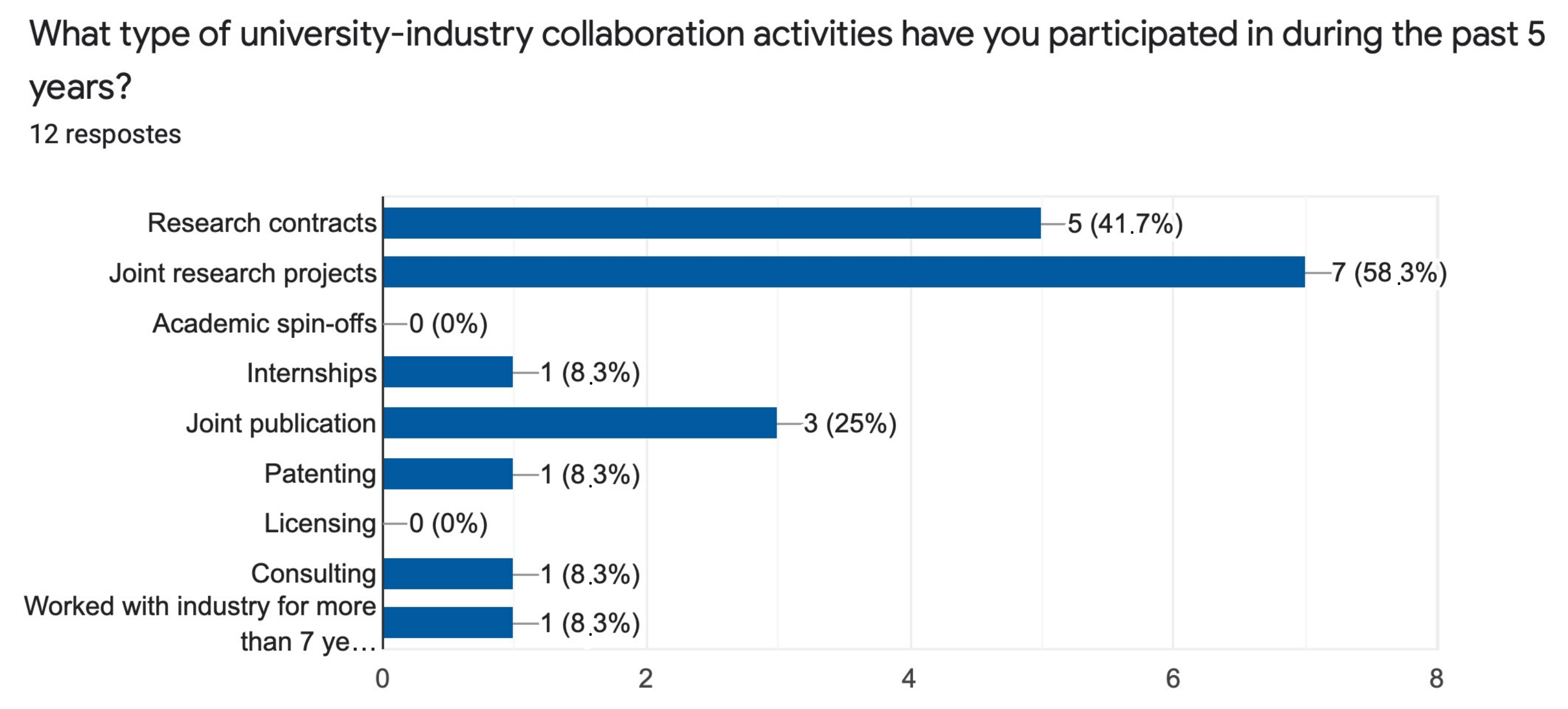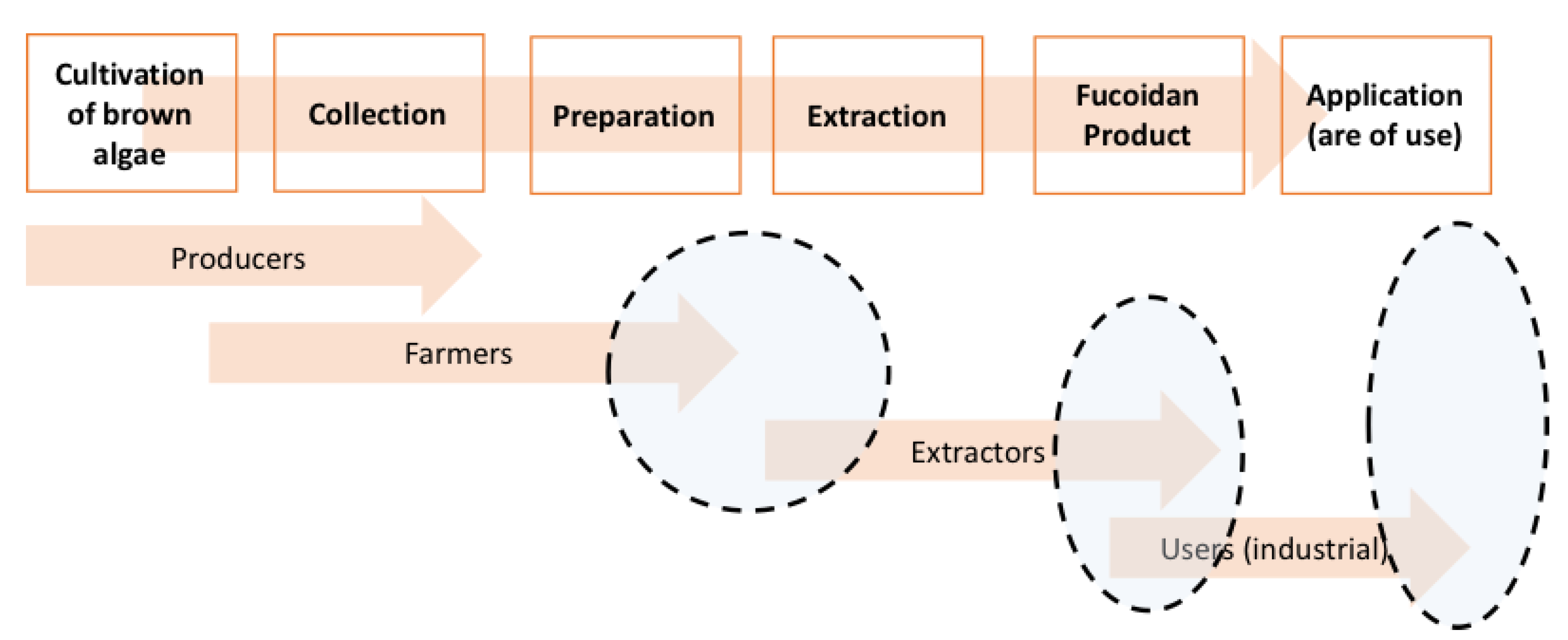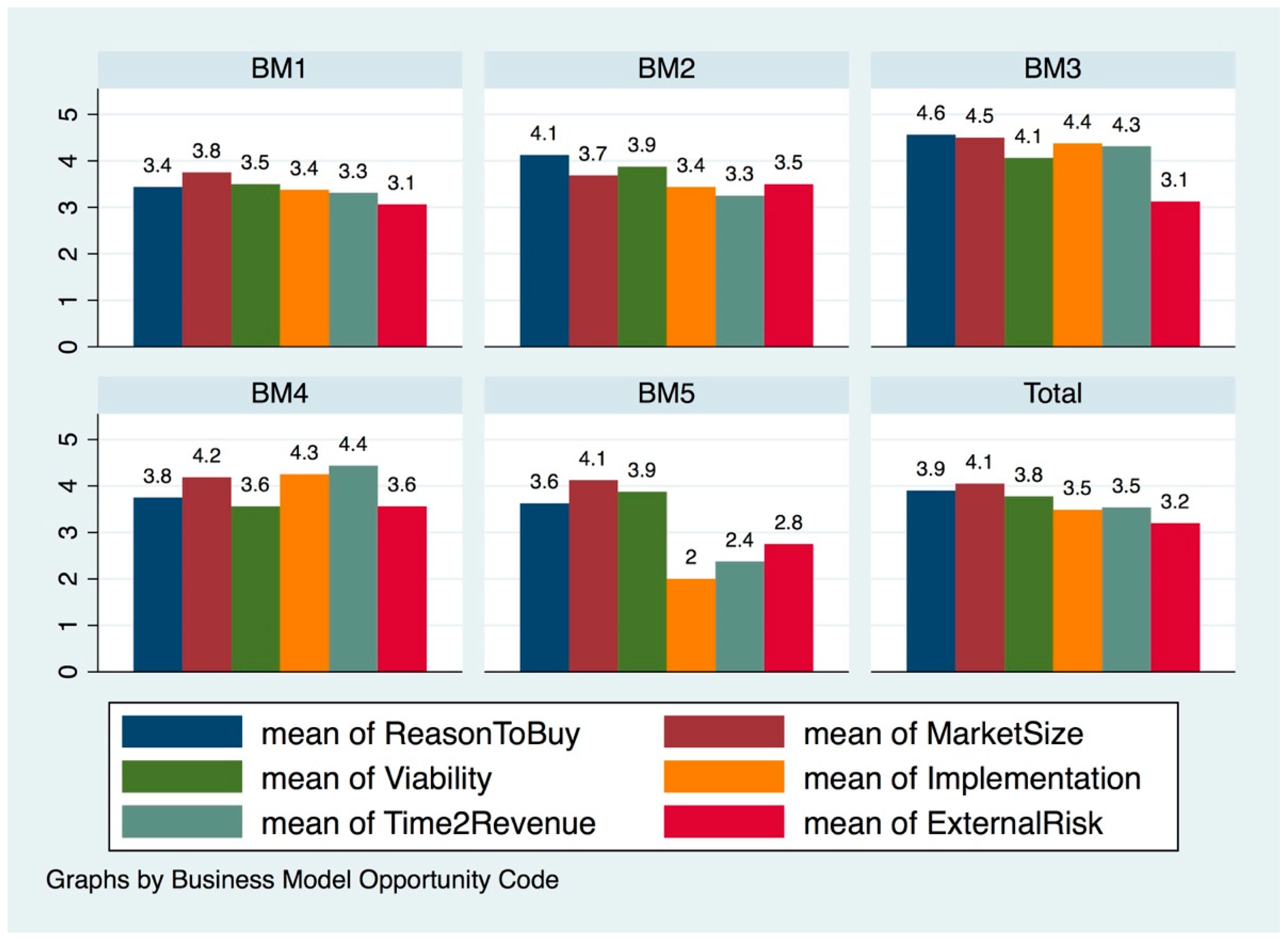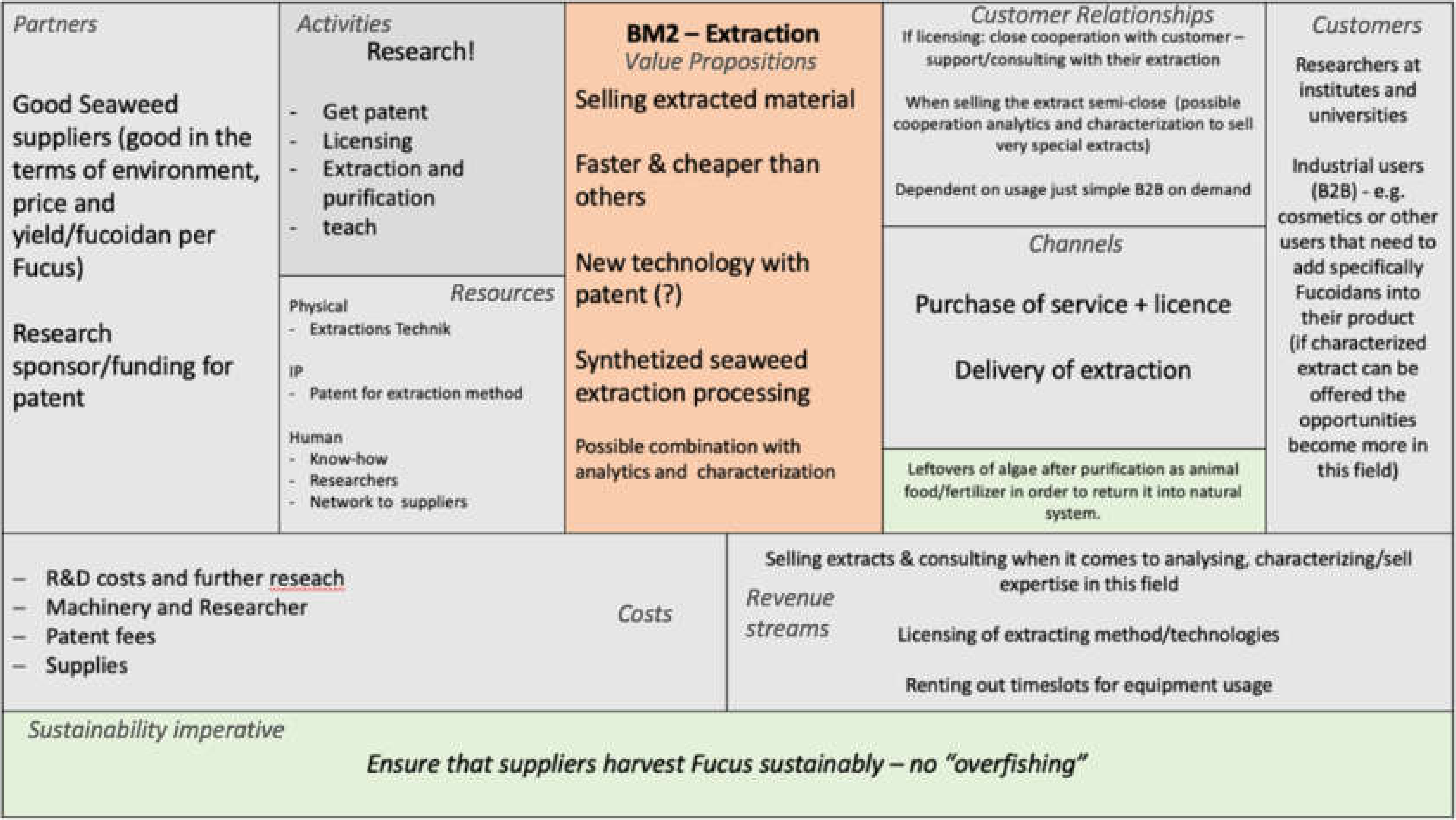Co-creating Science Commercialization Opportunities for Blue Biotechnologies: The FucoSan Project
Abstract
1. Introduction
2. Theoretical Framework
2.1. Impact as a Motivator for Science Commercialization
2.2. Scientists Engagement in Commercialization and Sustainability
2.3. Developing Sustainable Science Commercialization Opportunities with Business Models
3. Research Design
3.1. Research Setting: The Fucosan Project
3.2. Method
3.3. Data
4. Data Analysis and Results
Survey Results
5. Findings and Discussion
5.1. Science Commercialization as a Desirable But Not Necessarily Intended Behavior
5.2. Sustainability as the Glue to Tie Scientific and Societal Impact
5.3. An Attractive Science Commercialization Opportunity Is Not Enough
6. Implications
7. Limitations and Next Steps
8. Conclusions
Author Contributions
Funding
Acknowledgments
Conflicts of Interest
Appendix A
| Question | Response Type (Response Options) |
|---|---|
| Name of your organization/department | Open field |
| What type of organization is it? | Select one (from multiple option field) |
| SME | |
| Start-up | |
| Large Company | |
| University | |
| Research Centre | |
| Institution (local or regional) | |
| What type of university-industry collaboration activities have you done or been involved in the past (last 5 years)? Research contracts Joint research projects Academic spinoff Industry training (secondment) Joint publication Patenting Licensing | Multiple choice [18,52] |
| What is your overall satisfaction with your prior experiences on university-industry collaborations? | Very positive–Very negative Likert scale (1–7) |
| Any comments or thoughts you would like to share from your prior experiences? | Open question |
| In your opinion, what are the challenges in making university-industry collaborations work? | Likert scale (1–7) [22,39] (For the barriers questions, we use Bruneel et al. comments [39], also using [53] for the wording.) |
| University research is too orientated towards pure science. | |
| Differences in the sense of urgency between university and industry researchers. | |
| Lack of shared understanding about expectations and working practices. | |
| Tendency to oversell research outcomes or create unrealistic expectations. | |
| Potential conflicts regarding patents or other intellectual property rights. | |
| Different rules and regulations in university and industry. | |
| Absence of valid intermediaries that facilitate the collaboration. | |
| Other | Open question |
| Please indicate your level of agreement with the following sentences (total disagreement 1, total agreement 7): | Likert scale (1–7) Adapted from Linan & Chen [41] |
| Developing a university-industry collaboration is an attractive option. | |
| I see advantages in engaging in university-industry collaborations. | |
| In my organization there is a positive perception towards university-industry collaborations. | |
| I know the necessary details to start a university-industry collaboration. | |
| If I start a university-industry collaboration, I expect a high probability of success. | |
| In the short term (next months), I have as a goal to activate a university-industry collaboration. | |
| I am determined to start a university-industry collaboration in the near future (next year). | |
| How likely is it that you will attempt or engage in the following? | Very unlikely to Very likely. Likert scale (1–7). Assessing commercialization intentions [42] |
| License technology based on your research in the next 2 years? | Formal commercialization |
| Start a company based on your research in the next 2 years? | Formal commercialization |
| Engage in contract consultancy in the next 2 years? | Informal commercialization |
| Offer continuous professional development (training) in companies in the next 2 years? | Informal commercialization |
| Engage in contract research in the next 2 years? | Informal commercialization |
| How likely is it that you will engage in collaborative research in the next 2 years? | Informal commercialization |
| Others | Open field |
| Contact name | |
| Contact email |
Appendix B
| Question (For Each Business Model Opportunity) | Response Type (Response Options) |
|---|---|
| Is there a compelling reason to buy? Unmet need/effective solution/better than current solutions | Very low to Very high. Likert scale (1–5). Scale adapter from Market Opportunity Assessment tool [43]. |
| How large is the market? (current market size/expected growth) | |
| Is there economic viability (margin/customer stickiness) | |
| What about implementation obstacles (produce development or sales and distribution difficulties/funding challenges) | |
| Time to Revenue (development time/from product to market readiness/length of sale cycle) | |
| What about external risks (competitive threats/3rd party dependencies/barriers to adoption) |
References
- Rau, H.; Goggins, G.; Fahy, F. From invisibility to impact: Recognising the scientific and societal relevance of interdisciplinary sustainability research. Res. Policy 2018, 47, 266–276. [Google Scholar] [CrossRef]
- Cordova, M.F.; Celone, A. SDGs and innovation in the business context literature review. Sustainability 2019, 11, 7043. [Google Scholar] [CrossRef]
- Yin, W. Integrating Sustainable development goals into the belt and road initiative: Would it be a new model for green and sustainable investment? Sustainability 2019, 11, 6991. [Google Scholar] [CrossRef]
- Rodríguez-Díaz, B.; Pulido-Fernández, J.I. Sustainability as a key factor in tourism competitiveness: A global analysis. Sustainability 2019, 12, 51. [Google Scholar] [CrossRef]
- Shi, L.; Han, L.; Yang, F.; Gao, L. The evolution of sustainable development theory: Types, goals, and research prospects. Sustainability 2019, 11, 7158. [Google Scholar] [CrossRef]
- Cao, H.; Mikkelsen, M.; Lezyk, M.; Bui, L.; Tran, V.; Silchenko, A.; Kusaykin, M.; Pham, T.; Truong, B.; Holck, J.; et al. Novel enzyme actions for sulphated galactofucan depolymerisation and a new engineering strategy for molecular stabilisation of fucoidan degrading enzymes. Mar. Drugs 2018, 16, 422. [Google Scholar] [CrossRef]
- Manns, D.; Nielsen, M.M.; Bruhn, A.; Saake, B.; Meyer, A.S. Compositional variations of brown seaweeds Laminaria digitata and Saccharina latissima in Danish waters. J. Appl. Phycol. 2017, 29, 1493–1506. [Google Scholar] [CrossRef]
- Atashrazm, F.; Lowenthal, R.M.; Woods, G.M.; Holloway, A.F.; Dickinson, J.L. Fucoidan and cancer: A multifunctional molecule with anti-tumor potential. Mar. Drugs 2015, 13, 2327–2346. [Google Scholar] [CrossRef]
- Fitton, J.H.; Stringer, D.N.; Karpiniec, S.S. Therapies from fucoidan: An update. Mar. Drugs 2015, 13, 5920–5946. [Google Scholar] [CrossRef]
- Dörschmann, P.; Bittkau, K.S.; Neupane, S.; Roider, J.; Alban, S.; Klettner, A. Effects of fucoidans from five different brown algae on oxidative stress and VEGF interference in ocular cells. Mar. Drugs 2019, 17, 258. [Google Scholar] [CrossRef]
- Bittkau, K.S.; Dörschmann, P.; Blümel, M.; Tasdemir, D.; Roider, J.; Klettner, A.; Alban, S. Comparison of the effects of fucoidans on the cell viability of tumor and non-tumor cell lines. Mar. Drugs 2019, 17, 441. [Google Scholar] [CrossRef] [PubMed]
- Dörschmann, P.; Kopplin, G.; Roider, J.; Klettner, A. Effects of sulfated fucans from laminaria hyperborea regarding VEGF secretion, cell viability, and oxidative stress and correlation with molecular weight. Mar. Drugs 2019, 17, 548. [Google Scholar] [CrossRef]
- Rohwer, K.; Neupane, S.; Bittkau, K.S.; Pérez, M.G.; Dörschmann, P.; Roider, J.; Alban, S.; Klettner, A.; Pérez, G. Effects of crude fucus distichus subspecies evanescens fucoidan extract on retinal pigment epithelium cells―Implications for use in age-related macular degeneration. Mar. Drugs 2019, 17, 538. [Google Scholar] [CrossRef] [PubMed]
- Lüdeke-Freund, F. Sustainable entrepreneurship, innovation, and business models: Integrative framework and propositions for future research. Bus. Strateg. Environ. 2019. [Google Scholar] [CrossRef]
- Markman, G.D.; Russo, M.; Lumpkin, G.T.; Jennings, P.D.D.; Mair, J. Entrepreneurship as a platform for pursuing multiple goals: A special issue on sustainability, ethics, and entrepreneurship. J. Manag. Stud. 2016, 53, 673–694. [Google Scholar] [CrossRef]
- Fini, R.; Rasmussen, E.; Siegel, D.; Wiklund, J. Rethinking the commercialization of public science: From entrepreneurial outcomes to societal impacts. Acad. Manag. Perspect. 2018, 32, 4–20. [Google Scholar] [CrossRef]
- D’Este, P.; Ramos-Vielba, I.; Woolley, R.; Amara, N. How do researchers generate scientific and societal impacts? Toward an analytical and operational framework. Sci. Public Policy 2018, 45, 752–763. [Google Scholar] [CrossRef]
- Perkmann, M.; Tartari, V.; McKelvey, M.; Autio, E.; Broström, A.; D’Este, P.; Fini, R.; Geuna, A.; Grimaldi, R.; Hughes, A.; et al. Academic engagement and commercialisation: A review of the literature on university-industry relations. Res. Policy 2013, 42, 423–442. [Google Scholar] [CrossRef]
- Filippetti, A.; Savona, M. University-industry linkages and academic engagements: Individual behaviours and firms’ barriers. Introduction to the special section. J. Technol. Transf. 2017, 42, 719–729. [Google Scholar] [CrossRef]
- D’Este, P.; Ramos-Vielba, I.; Robinson-Garcia, N. Aligning scientific impact and societal relevance: The roles of academic engagement and interdisciplinary research. In Proceedings of the DRUID19, Copenhagen, Denmark, 19–21 June 2019. [Google Scholar]
- Azagra-Caro, J.M.; Llopis, O. Who do you care about? Scientists’ personality traits and perceived impact on beneficiaries. R&D Manag. 2018, 48, 566–579. [Google Scholar] [CrossRef]
- Tartari, V.; Salter, A.; D’Este, P. Crossing the rubicon: Exploring the factors that shape academics’ perceptions of the barriers to working with industry. Camb. J. Econ. 2012, 36, 655–677. [Google Scholar] [CrossRef]
- Ciarli, T.; Ràfols, I. The relation between research priorities and societal demands: The case of rice. Res. Policy 2019, 48, 949–967. [Google Scholar] [CrossRef]
- Wallace, M.L.; Ràfols, I. Institutional shaping of research priorities: A case study on avian influenza. Res. Policy 2018, 47, 1975–1989. [Google Scholar] [CrossRef]
- Shepherd, D.A.; McMullen, J.S.; Jennings, P.D. The formation of opportunity beliefs: Overcoming ignorance and reducing doubt. Strateg. Entrep. J. 2007, 1, 75–95. [Google Scholar] [CrossRef]
- Miller, K.D. Risk and rationality in entrepreneurial processes. Strateg. Entrep. J. 2007, 1, 57–74. [Google Scholar] [CrossRef]
- Mathisen, M.T.; Rasmussen, E. The development, growth, and performance of university spin-offs: A critical review. J. Technol. Transf. 2019. [Google Scholar] [CrossRef]
- Davidsson, P. Entrepreneurial opportunities and the entrepreneurship nexus: A re-conceptualization. J. Bus. Ventur. 2015, 30, 674–695. [Google Scholar] [CrossRef]
- Doganova, L.; Eyquem-Renault, M. What do business models do? Res. Policy 2009, 38, 1559–1570. [Google Scholar] [CrossRef]
- Fjeldstad, Ø.D.; Snow, C.C. Business models and organization design. Long Range Plan. 2017, 51, 32–39. [Google Scholar] [CrossRef]
- Dell’Era, C.; Magistretti, S.; Cautela, C.; Verganti, R.; Zurlo, F. Four kinds of design thinking: From ideating to making, engaging, and criticizing. Creat. Innov. Manag. 2020. [Google Scholar] [CrossRef]
- Osterwalder, A.; Pigneur, Y. Business Model. Generation: A Handbook for Visionaries, Game Changers, and Challengers, 1st ed.; Clark, T., Ed.; Wiley: Hoboken, NJ, USA, 2010; ISBN 978-0470876411. [Google Scholar]
- Rasmussen, E.; Mathisen, M.T. Science-based entrepreneurial firms as real options: Assessing the outcomes of the Norwegian firm population from 1995 to 2012. In The World Scientific Reference in Entrepreneurship; World Scientific: Singapore, 2016. [Google Scholar]
- Markman, G.D.; Siegel, D.S.; Wright, M. Research and technology commercialization. J. Manag. Stud. 2008, 45, 1401–1423. [Google Scholar] [CrossRef]
- Barbosa, A.I.; Coutinho, A.J.; Costa Lima, S.A.; Reis, S. Marine polysaccharides in pharmaceutical applications: Fucoidan and chitosan as key players in the drug delivery match field. Mar. Drugs 2019, 17, 654. [Google Scholar] [CrossRef] [PubMed]
- Creswel, J.W. The selection of a research approach. In Reserch Design—Qualitative, Quantitative and Mixed Methods Approaches; Sage Publications, Inc.: Thousand Oaks, CA, USA, 2008; pp. 3–22. [Google Scholar]
- Molina-Azorin, J.F. Mixed methods research in strategic management: Impact and applications. Organ. Res. Methods 2010, 15, 33–56. [Google Scholar] [CrossRef]
- Klag, M.; Langley, A. Approaching the conceptual leap in qualitative research. Int. J. Manag. Rev. 2013, 15, 149–166. [Google Scholar] [CrossRef]
- Bruneel, J.; D’Este, P.; Salter, A. Investigating the factors that diminish the barriers to university–industry collaboration. Res. Policy 2010, 39, 858–868. [Google Scholar] [CrossRef]
- Giones, F. University-industry collaborations: An industry perspective. Manag. Decis. 2019, 57, 3258–3279. [Google Scholar] [CrossRef]
- Liñán, F.; Chen, Y.-W. Development and cross-cultural application of a specific instrument to measure entrepreneurial intentions. Entrep. Theory Pract. 2009, 33, 593–617. [Google Scholar] [CrossRef]
- Johnson, M.; Monsen, E.W.; MacKenzie, N.G. Follow the leader or the pack? Regulatory focus and academic entrepreneurial intentions. J. Prod. Innov. Manag. 2017, 34, 181–200. [Google Scholar] [CrossRef]
- Gruber, M.; Tal, S. Where to Play: 3 Steps for Discovering Your Most Valuable Market Opportunities; Pearson: London, UK, 2017; ISBN 978-1292178929. [Google Scholar]
- Hansen, M.T.; Birkinshaw, J. The innovation value chain. Harvard Bus. Rev. 2007, 85, 121–131. [Google Scholar]
- Shane, S.A. Prior knowledge and the discovery of entrepreneurial opportunities. Organ. Sci. 2000, 25, 448–469. [Google Scholar] [CrossRef]
- Neupane, S.; Bittkau, K.S.; Sandow, V.; Ptak, S.; Mikkelsen, M.D.; Dörschmann, P.; Ohmes, J.; Frette, X.; Meyer, A.S.; Fuchs, S.; et al. FucoSan: Extraction of fucoidans from different brown algae species using different methods and their chemical and biological characterization. Zenodo 2020. [Google Scholar] [CrossRef]
- Mangematin, V.; O’Reilly, P.; Cunningham, J.A. PIs as boundary spanners, science and market shapers. J. Technol. Transf. 2014, 39, 1–10. [Google Scholar] [CrossRef]
- Giones, F.; Ungerer, C.; Baltes, G. Balancing financial, social, and environmental values: Can new ventures make an impact without sacrificing profits? Int. J. Entrep. Ventur. 2019, 1–24. [Google Scholar] [CrossRef]
- Li, J.F.; Garnsey, E. Policy-driven ecosystems for new vaccine development. Technovation 2014, 34, 762–772. [Google Scholar] [CrossRef]
- Cunningham, J.A.; O’Reilly, P.; O’Kane, C.; Mangematin, V. The inhibiting factors that principal investigators experience in leading publicly funded research. J. Technol. Transf. 2014, 39, 93–110. [Google Scholar] [CrossRef]
- Woolley, J.L. The Creation and configuration of infrastructure for entrepreneurship in emerging domains of activity. Entrep. Theory Pract. 2014, 38, 721–747. [Google Scholar] [CrossRef]
- D’Este, P.; Patel, P.C. University-industry linkages in the UK: What are the factors underlying the variety of interactions with industry? Res. Policy 2007, 36, 1295–1313. [Google Scholar] [CrossRef]
- Al-Tabbaa, O.; Ankrah, S. Social capital to facilitate ‘engineered’ university–industry collaboration for technology transfer: A dynamic perspective. Technol. Forecast. Soc. Chang. 2016, 104, 1–15. [Google Scholar] [CrossRef]





| Type of Participant | Role in the Innovation Value Chain | Main Activity | |
|---|---|---|---|
| Project members | Research University A | Research on the extraction processes from the brown algae. | Scientific research—extraction |
| Research University B | Research on the extraction methods using enzymes to advance the purification process. | Scientific research—purification | |
| Research University C | Research on the characterization of fucoidan and bioactivity standardization. | Scientific research—pharmacology | |
| Research University D | Research on medical applications of promising biomarine products (in animals). | Scientific research—medical area | |
| Research University E | Research on medical applications of promising biomarine products (in humans). | Scientific research—medical area | |
| Research institute— public/private centre | Exploration of fucoidan application by testing its properties and bioactivity. | Scientific research—testing and exploration of applications | |
| Private company | Harvesting and extraction of the raw fucoidan material from the brown algae. | Process innovation development | |
| Private company | Application in cosmetic and other direct consumer markets of products with fucoidan. | Product innovation development | |
| Project stakeholders | Regional biomarine business association | Activation of collaborations across actors involved in biomarine research. | Support and advice |
| Regional Biomedical cluster organization | Activation of partnerships and collaborations with the medical industry. | Support and advice | |
| Private company | Support in the commercialization of natural medical products. | Advice and market insights | |
| Type of Data Collection | Description of the Data Collection Activity | Date |
|---|---|---|
| Survey (Appendix A) responses | Administration of baseline survey (Appendix A) to the project participants and individual interviews. | February 2018 |
| Qualitative inputs and feedback (workshops minutes) | Survey results presentation and discussion on the meaning of the results and specific concerns and challenges. Initial identification of possible business opportunities. | February and May 2018 |
| Survey (Appendix B) responses and group discussion | Administration of survey (Appendix B) in a project workshop, with discussion of the results to clarify responses. | February 2019 |
| Qualitative inputs and feedback (workshop minutes) | Workshop to validate and refine possible business model designs and their potential. | June 2019 |
| (Theme) Questions | Variable Measurement (Reference, if Any) |
|---|---|
| (1) What type of university-industry collaboration (UIC) activities have you done or been involved in in the past (last 5 years)? (see annex for further details) | Types (listed) of university-industry collaboration [18]. |
| (1) What is your overall satisfaction with your prior experiences on university-industry collaborations? | Very positive–Very negative, using a Likert scale (1–7). |
| (2) In your opinion, what are the challenges in making university-industry collaborations work? (see annex for further details) | Orientation vs. transaction (listed) barriers [22,39], using a Likert scale (1–7). |
| (3) Please indicate your level of agreement with the following sentences on intentions, knowledge, perceptions, plans on engaging in UIC. (see annex for further details) | UIC intentions and perceptions [40] using a Likert scale (1–7) adapted from Linan & Chen [41]. |
| (4) How likely is it that you attempt or engage in the following activities (licensing, starting a company, consultancy…)? (see annex for further details) | Intentions to engage in formal and informal research commercialization [42] using a Likert scale (1–7). |
| Questions | Variable Measurement (Reference) |
|---|---|
| Is there a compelling reason to buy? (unmet need/effective solution/better than current solutions)—ReasonToBuy | The measured variables are the complete list suggested by Gruber & Tal [43] to assess the market opportunities. For each question a Likert scale (1–5) is used. |
| How large is the market? (current market size/expected growth)—MarketSize | |
| Is there economic viability? (margin/customer stickiness)—Viability | |
| What about implementation obstacles? (produce development or sales and distribution difficulties/funding challenges)—Implementation | |
| Time to Revenue (development time/from product to market readiness/length of sale cycle)—Time2Revenue | |
| What about external risks (competitive threats/3rd party dependencies/barriers to adoption)—ExternalRisk |
| Mean | sd | Min | Max | |
|---|---|---|---|---|
| +/− UIC experience | 5.5 | 0.67 | 4 | 6 |
| Orient. research | 4 | 1.34 | 2 | 6 |
| Orient. diff | 4.16 | 1.33 | 2 | 6 |
| Orient. Underst | 4.42 | 1.67 | 2 | 7 |
| Orient. oversell | 4.25 | 1.65 | 2 | 7 |
| Trans. IP conf | 4.41 | 1.56 | 2 | 6 |
| Trans. rules | 5.08 | 0.79 | 4 | 6 |
| Trans. intermed | 3.83 | 1.64 | 1 | 7 |
| UIC attract | 5.92 | 0.51 | 5 | 7 |
| UIC advantage | 5.92 | 0.67 | 5 | 7 |
| UIC positive | 5.08 | 1.24 | 2 | 6 |
| UIC knowledge | 4 | 1.76 | 1 | 6 |
| UIC success | 4.58 | 1.44 | 2 | 6 |
| UIC intention | 3.75 | 2.18 | 1 | 7 |
| Licensing | 3.25 | 1.36 | 1 | 5 |
| Startup | 1.75 | 1.14 | 1 | 5 |
| Consulting | 2.75 | 1.29 | 1 | 6 |
| prof develop | 2.17 | 0.94 | 1 | 4 |
| contract res. | 3.58 | 1.31 | 2 | 6 |
| engage UIC | 4.42 | 1.68 | 2 | 6 |
| N 12 | ||||
| Mean | sd | Min | Max | |
|---|---|---|---|---|
| ReasonToBuy | 3.9 | 0.99 | 1 | 5 |
| MarketSize | 4.05 | 0.88 | 2 | 5 |
| Viability | 3.77 | 0.91 | 2 | 5 |
| Implementation | 3.49 | 1.27 | 1 | 5 |
| Time2Revenue | 3.54 | 1.28 | 1 | 5 |
| ExternalRisk | 3.2 | 1.09 | 1 | 5 |
| N 16 | ||||
© 2020 by the authors. Licensee MDPI, Basel, Switzerland. This article is an open access article distributed under the terms and conditions of the Creative Commons Attribution (CC BY) license (http://creativecommons.org/licenses/by/4.0/).
Share and Cite
Giones, F.; Laufs, D.; Schultz, C. Co-creating Science Commercialization Opportunities for Blue Biotechnologies: The FucoSan Project. Sustainability 2020, 12, 5578. https://doi.org/10.3390/su12145578
Giones F, Laufs D, Schultz C. Co-creating Science Commercialization Opportunities for Blue Biotechnologies: The FucoSan Project. Sustainability. 2020; 12(14):5578. https://doi.org/10.3390/su12145578
Chicago/Turabian StyleGiones, Ferran, Daniel Laufs, and Carsten Schultz. 2020. "Co-creating Science Commercialization Opportunities for Blue Biotechnologies: The FucoSan Project" Sustainability 12, no. 14: 5578. https://doi.org/10.3390/su12145578
APA StyleGiones, F., Laufs, D., & Schultz, C. (2020). Co-creating Science Commercialization Opportunities for Blue Biotechnologies: The FucoSan Project. Sustainability, 12(14), 5578. https://doi.org/10.3390/su12145578





